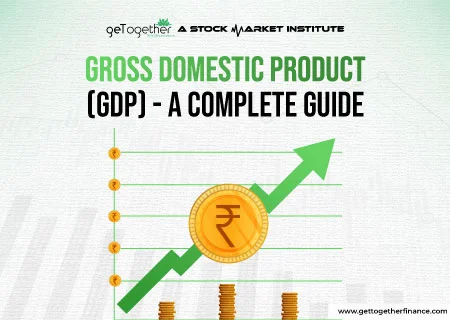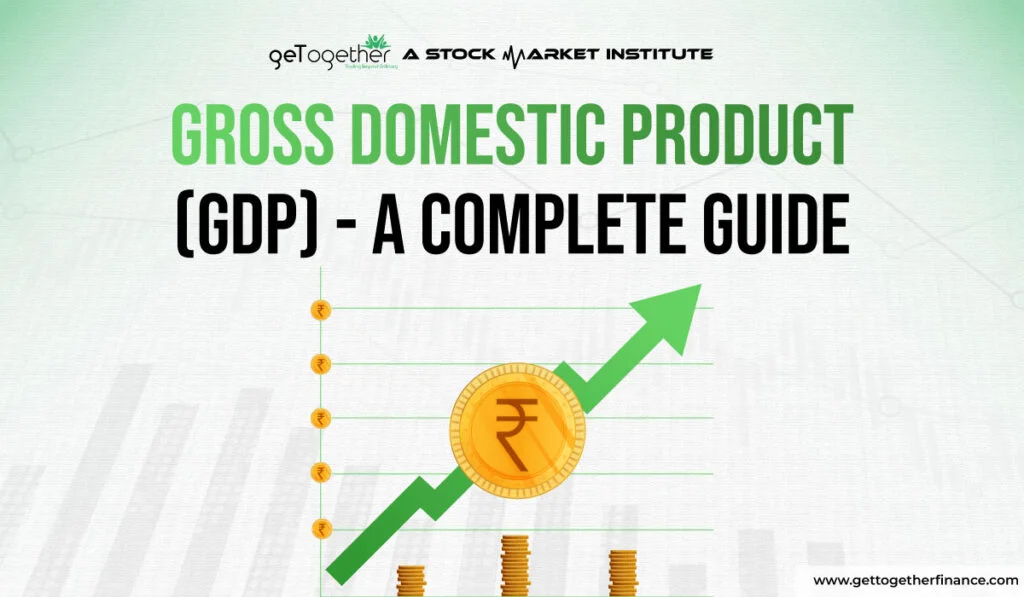Gross Domestic Product (GDP) – A Complete Guide


Table of Contents
ToggleOverview
The size of a country’s economy is expressed by its GDP numbers and is a factor of macroeconomics. Calculating GDP includes measuring the total monetary value of everything a country produces in a year. This includes a vast array of goods and services, from everyday items to complex technologies and educational programs. This e-guide will explain what is gross domestic product (GDP), the different types of GDP, and how to calculate it using different methods.
What is the Gross Domestic Product (GDP)?

Gross Domestic Product is the total value of all goods and services produced within a country during a specific period, usually a financial year. It shows how much a country is developing and progressing economically. GDP is a key indicator of a country’s economic health, reflecting people’s standard of living, economic growth, and overall well-being.
It measures a country’s economic performance, helping policymakers make informed decisions about fiscal and monetary policies. The main purpose of GDP is to provide a comprehensive overview of a country’s economic output. Economists, investors, and analysts widely use it to assess economic health.
According to the International Monetary Fund, India was among the top 10 countries in the world by nominal GDP in 2023. GDP is crucial for governments, businesses, and individuals to understand a country’s economic performance and make informed decisions about monetary activities.
What Are The Different Types of Gross Domestic Product (GDP)

Gross Domestic Product can be classified into different types based on how inflation (price changes) are factored in. Here’s a brief explanation of the two most common types:
Real GDP
Real GDP calculates the total value of goods and services produced in an economy but with the prices adjusted for inflation. This means it reflects the value of production using constant prices (usually from a base year). Real Gross Domestic Product is a more accurate measure of economic growth over longer periods because it removes the distorting effect of inflation. By using constant prices, you can compare the actual increase in the volume of goods and services produced.
To calculate the Real GDP for 2021, we need to adjust the nominal GDP (₹200 lakh crore) for inflation (5%).
Nominal GDP
Nominal GDP measures the total value of goods and services produced in an economy at current market prices. This means it reflects the prices staying in the year the Gross Domestic Product is calculated.
Nominal GDP is useful for comparing a country’s economic growth within a short timeframe (like year-to-year comparisons) because it uses the same year’s prices. This allows for a more direct comparison without the distorting effect of inflation.
The Cost Inflation Index is the ratio of both nominal and real GDP.
Also Read: Budget 2024
How to Calculate Gross Domestic Product (GDP)?

There are three main approaches to calculating Gross Domestic Product, each focusing on a different aspect of the economy:
Expenditure Method
This method calculates GDP by summing up the final expenditures of all sectors in the economy. In simpler terms, it adds up the total amount of money spent on goods and services produced within the country during a specific period. Here’s the breakdown:
- Formula: GDP (Expenditure Method) = C + G + I + NX
Where:
- Consumption Expenditure (C): Spending by households on goods and services.
- Government Expenditure (G): Spending by the government on goods and services.
- Investment Expenditure (I): Spending by businesses on new capital goods (equipment, buildings) and inventories.
- Net Exports (NX): Exports (goods and services sold abroad) minus Imports (goods and services bought from abroad).
Output Method
This method calculates GDP by summing up the value of all final goods and services produced within the country during a specific period. It essentially focuses on the production side of the economy. Here’s what’s included:
Formula: GDP (Output Method) = Σ (Gross Value Added across all industries)
Where
- Gross Value Added (GVA): The market value of goods and services produced by an industry, minus the value of intermediate goods and services used up in production (e.g., flour used by a bakery wouldn’t be counted again).
Income Method
This method calculates Gross Domestic Product by summing up all the income earned by the factors of production (labour, capital, land, and entrepreneurship) within the country during a specific period. It focuses on how income is distributed in the economy.
- Formula: GDP (Income Method) = W + Profits + Net Indirect Taxes
Where:
- Compensation of Employees (Wages & Salaries): Income earned by employees.
- Gross Operating Surplus (Profits): Profits of businesses and income of self-employed individuals.
- Net Indirect Taxes (Taxes on Production & Imports): Indirect taxes levied on production and imports, minus subsidies provided by the government.
Note: In theory, all three methods should arrive at the same value for GDP, although there might be slight discrepancies due to rounding and statistical adjustments.
GDP vs Stock market

Gross Domestic Product (GDP) and the stock market are like two sides of the same economic coin. While they measure different aspects, they are intricately linked in a constant dance that shows both the health and sentiment of a country’s economy.
GDP serves as the foundation for the stock market’s performance. A strong and growing GDP signals a healthy economy with robust production of goods and services. It shows a thriving economy, increased corporate profits, business investment, and overall confident outlook of investors. Contrary, a strong stock market also positively impacts GDP.
Here’s how:
- Wealth Effect: A rising stock market creates a “wealth effect,” where individuals feel wealthier due to the increase in their stock holdings. This can lead to increased consumer spending, contributing to GDP growth.
- Business Confidence: A bullish stock market signifies investor optimism, boosting business confidence. This can encourage companies to invest more, hire new employees, and expand production, all leading to higher GDP.
It’s important to remember that the relationship between GDP and the stock market isn’t always perfectly synchronised. Due to the dynamic and volatile nature of the stock market, it may not always reflect the underlying economic health and create a speculative (trader’s) bubble, giving an impression of good GDP, only to leave investors dry hands with fool’s gold.
What Are The Limitations Of Gross Domestic Product (GDP)?

GDP, while a widely used metric, has limitations that users should be aware of when interpreting a country’s economic health. Here are some key limitations:
- Focus on Quantity, Not Quality: Gross Domestic Product measures the total monetary value of goods and services produced. It doesn’t account for the quality of those goods and services, nor the well-being of the population. For example, a high GDP might coexist with increased pollution or social inequality.
- Informal Economy Omission: Underground economic activity, such as barter transactions or cash-based businesses, is often not captured in GDP calculations. This can lead to an underestimation of the true size of the economy.
- Environmental Impact Ignored: Gross Domestic Product doesn’t consider the environmental costs associated with economic production. Activities like resource depletion and pollution aren’t factored in, presenting a one-sided view of economic growth.
- Income Distribution Blindspot: Gross Domestic Product doesn’t tell you how income is distributed within a country. A high GDP might not benefit all citizens equally, and wealth might be concentrated in the hands of a few.
- Social Progress Neglect: Gross Domestic Product focuses solely on economic factors and doesn’t consider social progress indicators like education levels, healthcare access, or overall quality of life.
GDP of India 2024: Highlights
India’s GDP is estimated to be around $4.038 trillion (nominal) in 2024. The economy is expected to grow by 8.2% in FY 2024 (fiscal year ending March 2025), following a 7.2% growth in FY 2023. This makes India one of the fastest-growing major economies in the world.
India is currently estimated to be the 5th largest economy in the world in terms of nominal GDP. In terms of Purchasing Power Parity (PPP), which considers the relative cost of living, India ranks 3rd globally.
In India, the Gross Domestic Product of the country contains major three key sector segmentations, agriculture, industry, and other associated services. Growth of agriculture dropped from 4.7% to 1.4%, potentially impacting overall GDP. Where the manufacturing strength increased by 9.9%, a positive sign for the economy. Despite this, the electricity and mining sectors show steady growth to 7%, offering major support to other sectors.
Conclusion
GDP is an essential metric for evaluating a country’s economic health and development. It offers a comprehensive view of the economic activity of a country, reflecting the standard of living, growth, and overall well-being of a nation’s citizens. By assessing Gross Domestic Product, policymakers can make informed decisions regarding fiscal and monetary policies, while businesses and investors can gauge economic performance and strategise accordingly. Understanding GDP helps governments, businesses, and individuals make informed decisions that drive economic prosperity and stability.
FAQs
What is inflation?
Inflation refers to the gradual increase in the prices of goods and services in an economy over time. When inflation hits an economy, the prices of services or products often increase, and the purchasing power of a currency decreases.
Does a higher GDP always mean a better economy?
Not necessarily. Gross Domestic Product focuses on quantity, not quality of life or income distribution. A high GDP might coexist with social problems.
What is the difference between nominal GDP and real GDP in India?
Nominal GDP uses current market prices to value India’s production, so it reflects inflation. Real GDP adjusts for inflation, giving a clearer picture of actual growth in the volume of goods and services
Where can I find more information about India’s GDP?
Go to the official websites like the World Bank, International Monetary Fund (IMF), and India’s Ministry of Statistics and Programme Implementation can offer insights.
What is the average GDP growth rate India has achieved in the last decade?
The average GDP growth rate for India in the last decade (2014-2024) can vary depending on the data source. However, it’s estimated to be around 7%.
Will India become a $5 trillion economy by 2025?
This is a prediction, and reaching the $5 trillion mark by 2025 totally depend on various factors like global economic conditions and the effectiveness of government policies. While achieving this milestone is possible, it’s not guaranteed.



 Facebook
Facebook Instagram
Instagram Youtube
Youtube
